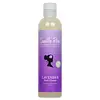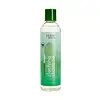What's inside
What's inside
 Key Ingredients
Key Ingredients

No key ingredients
 Benefits
Benefits

 Concerns
Concerns

 Ingredients Side-by-side
Ingredients Side-by-side

Water
Skin ConditioningSodium C14-16 Olefin Sulfonate
CleansingDisodium Cocoamphodipropionate
CleansingCocamidopropyl Betaine
CleansingVinegar
Malva Sylvestris Flower Extract
Skin ConditioningHedera Helix Extract
AntimicrobialParietaria Officinalis Extract
EmollientCucumis Sativus Fruit Extract
EmollientSambucus Nigra Extract
Skin ConditioningArnica Montana Flower Extract
MaskingCitric Acid
BufferingSodium Cocoyl Isethionate
CleansingGlycol Distearate
EmollientPolyquaternium-10
Polyquaternium-7
Lavandula Angustifolia Oil
MaskingPhenoxyethanol
PreservativeEthylhexylglycerin
Skin ConditioningParfum
MaskingWater, Sodium C14-16 Olefin Sulfonate, Disodium Cocoamphodipropionate, Cocamidopropyl Betaine, Vinegar, Malva Sylvestris Flower Extract, Hedera Helix Extract, Parietaria Officinalis Extract, Cucumis Sativus Fruit Extract, Sambucus Nigra Extract, Arnica Montana Flower Extract, Citric Acid, Sodium Cocoyl Isethionate, Glycol Distearate, Polyquaternium-10, Polyquaternium-7, Lavandula Angustifolia Oil, Phenoxyethanol, Ethylhexylglycerin, Parfum
Water
Skin ConditioningSodium C14-16 Olefin Sulfonate
CleansingCocamidopropyl Betaine
CleansingMentha Piperita Oil
MaskingHydrolyzed Wheat Protein
Skin ConditioningPanthenol
Skin ConditioningTocopheryl Acetate
AntioxidantGlycerin
HumectantMelaleuca Alternifolia Leaf Oil
AntioxidantPolyquaternium-10
Disodium Laureth Sulfosuccinate
CleansingSodium Lauryl Sulfoacetate
CleansingSodium Sulfate
Dipropylene Glycol
HumectantEucalyptol
PerfumingCamphor
MaskingPEG-150 Distearate
EmulsifyingSodium Chloride
MaskingCitric Acid
BufferingPolysorbate 20
EmulsifyingTetrasodium EDTA
Phenoxyethanol
PreservativeMethylchloroisothiazolinone
PreservativeMethylisothiazolinone
PreservativeWater, Sodium C14-16 Olefin Sulfonate, Cocamidopropyl Betaine, Mentha Piperita Oil, Hydrolyzed Wheat Protein, Panthenol, Tocopheryl Acetate, Glycerin, Melaleuca Alternifolia Leaf Oil, Polyquaternium-10, Disodium Laureth Sulfosuccinate, Sodium Lauryl Sulfoacetate, Sodium Sulfate, Dipropylene Glycol, Eucalyptol, Camphor, PEG-150 Distearate, Sodium Chloride, Citric Acid, Polysorbate 20, Tetrasodium EDTA, Phenoxyethanol, Methylchloroisothiazolinone, Methylisothiazolinone
Ingredients Explained
These ingredients are found in both products.
Ingredients higher up in an ingredient list are typically present in a larger amount.
Citric Acid is an alpha hydroxy acid (AHA) naturally found in citrus fruits like oranges, lemons, and limes.
Like other AHAs, citric acid can exfoliate skin by breaking down the bonds that hold dead skin cells together. This helps reveal smoother and brighter skin underneath.
However, this exfoliating effect only happens at high concentrations (20%) which can be hard to find in cosmetic products.
Due to this, citric acid is usually included in small amounts as a pH adjuster. This helps keep products slightly more acidic and compatible with skin's natural pH.
In skincare formulas, citric acid can:
While it can provide some skin benefits, research shows lactic acid and glycolic acid are generally more effective and less irritating exfoliants.
Most citric acid used in skincare today is made by fermenting sugars (usually from molasses). This synthetic version is identical to the natural citrus form but easier to stabilize and use in formulations.
Read more about some other popular AHA's here:
Learn more about Citric AcidCocamidopropyl Betaine is a fatty acid created by mixing similar compounds in coconut oil and dimethylaminopropylamine, a compound with two amino groups.
This ingredient is a surfactant and cleanser. It helps gather the dirt, pollutants, and other impurities in your skin to be washed away. It also helps thicken a product and make the texture more creamy.
Being created from coconut oil means Cocamidopropyl Betaine is hydrating for the skin.
While Cocamidopropyl Betaine was believed to be an allergen, a study from 2012 disproved this. It found two compounds in unpure Cocamidopropyl Betaine to be the irritants: aminoamide and 3-dimethylaminopropylamine. High-grade and pure Cocamidopropyl Betaine did not induce allergic reactions during this study.
Learn more about Cocamidopropyl BetainePhenoxyethanol is a preservative that has germicide, antimicrobial, and aromatic properties. Studies show that phenoxyethanol can prevent microbial growth. By itself, it has a scent that is similar to that of a rose.
It's often used in formulations along with Caprylyl Glycol to preserve the shelf life of products.
Polyquaternium-10 is an ammonium salt of hydroxyethylcellulose. It is a white and granular powder used as a film-former and anti-static agent.
This ingredient is commonly found in hair conditioning products. According to a manufacturer, its positive charge makes it great for absorbing hair proteins. The manufacturer also states this ingredient helps with curl retention.
For haircare friends: this ingredient is not a silicone.
Learn more about Polyquaternium-10Sodium C14-16 Olefin Sulfonate is a cleansing agent made from a mixture of long chain sulfonate salts. It can also help produce foam.
This ingredient may be drying. We recommend speaking with a professional if you have concerns.
Water. It's the most common cosmetic ingredient of all. You'll usually see it at the top of ingredient lists, meaning that it makes up the largest part of the product.
So why is it so popular? Water most often acts as a solvent - this means that it helps dissolve other ingredients into the formulation.
You'll also recognize water as that liquid we all need to stay alive. If you see this, drink a glass of water. Stay hydrated!
Learn more about Water